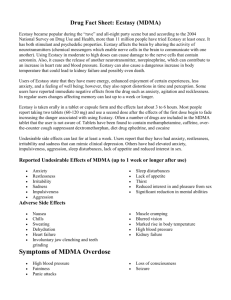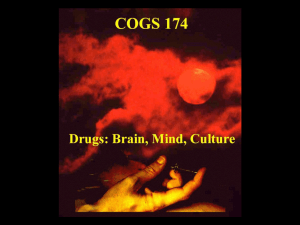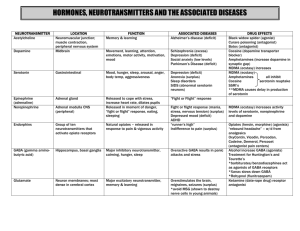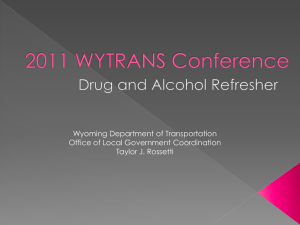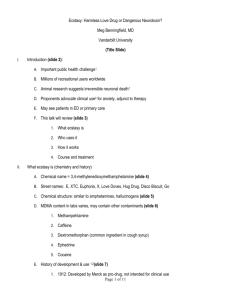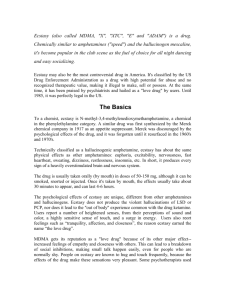Drug Information - Rowan University
advertisement
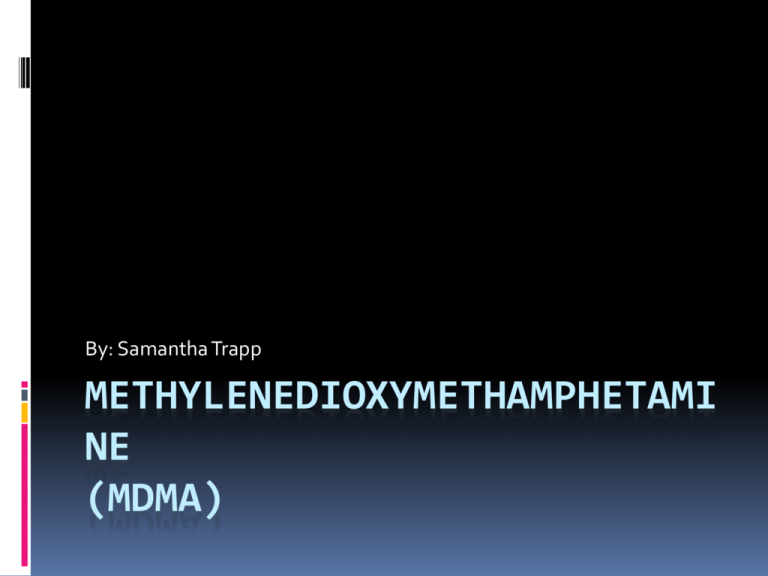
By: Samantha Trapp METHYLENEDIOXYMETHAMPHETAMI NE (MDMA) Do you know another name? Ecstasy Street names, brand names, & chemical name Methylenedioxymethamphetamine (MDMA) is the chemical. Ecstasy is the street name along with many other names. Here are a few: * X, E, or XTC * Adam * Beans * Candy * Dancing Shoes * Disco Biscuits * Doves * E-bomb * Egg Rolls * Happy Pill * Hug Drug * Love Drug * Malcolm (or Malcolm X) * Scooby Snacks * Smartees * Sweets * Skittles * Thizz * Vitamin E or Vitamin X * Vowels Slang terms: * Drop, Double Drop * Thizzing * Flip or Flipping * Roll, Rolling * Cuddle Puddle, E-Puddle * E-tard * Raver, Raving Chemical name The German company that invented MDMA, Merck, originally patented it in 1912 under the name 'methylsafrylamin'. Thus, there are no real brand or generic names for MDMA, since MDMA is not used for pharmaceutical use. Description of drug MDMA is an illegal drug that acts as both a stimulant and "hallucinogen", producing an energizing effect, as well as distortions in time and perception and enhanced enjoyment from tactile experiences. History & Medical Use MDMA was patented in 1913 by the German chemical company, Merck, supposedly to be sold as a diet pill. The man responsible for the modern research of MDMA is Alexander Shulgin, who is also reported to be the first person to use it. In the late 1970s, MDMA was used to facilitate psychotherapy by a small group of therapists in the United States In 1985, MDMA/Ecstasy received massive media attention when a group of people sued the US Drug Enforcement Agency (DEA) to try to prevent them from outlawing the drug by placing it on Schedule 1. The US Congress had passed a new law allowing the DEA to put an emergency ban on any drug that it thought might be a danger to the public. On July 1st 1985, this right was used for the first time to ban MDMA. Illicit use of the drug did not become popular until the late 1980s and early 1990s. Trial research into the effects of MDMA on human volunteers resumed in 1993 with the approval of the Food and Drug Administration (FDA), the first psychoactive drug approved for human testing by the FDA. Schedule rating of MDMA MDMA was listed as a class A drug in the UK in 1977 and placed into Schedule I of the Misuse of Drugs Act, 1971. Equivalent to the FDA's schedule I rating, MDMA is deemed to have no medicinal use. Physiological Effects Ecstasy is both a hallucinogenic and a stimulant drug. It makes users experience a rush of good feelings (a high) and makes someone's feelings much more intense, whether they're good or bad. The drug's effects usually last up to 6 hours. Ecstasy increases heart rate and can cause dry mouth, clenched teeth, blurred vision, chills, sweating, or nausea. It can make some users feel anxious, confused, and paranoid, like someone is trying to hurt them or is plotting against them. Ecstasy may cause direct damage to brain cells that are involved in thinking and memory. If a person takes Ecstasy, his or her body can dangerously overheat during dancing or other physical activities, which can lead to muscle breakdown, kidney, liver and heart damage, and even death. Taking the drug can cause seizures, brain swelling and permanent brain damage. Psychological Effects Pleasure Self-confidence Increased energy Peacefulness Acceptance Empathy Feelings of closeness with others and a desire to touch them Short Term Side Effects The effects start after about 20 minutes and can last for hours. Short-term effects of ecstasy abuse: Nausea Hallucinations Chills and sweating Increased body temp Tremors Muscle cramping Blurred vision Anxiety Depression Paranoia Cognitive impairments changes in emotion Learning Memory Hormone-like chemical abnormalities. Long Term Side Effects Long-term effects of ecstasy abuse: damage to the neurons in the brain that transmit serotonin permanent brain damage depression anxiety memory loss other neuropsychotic disorders Physiological Effects Interfere with a number of neurotransmitters systems, Serotonin, Dopamine, Noradrenaline, And body systems including the heart, brain, liver, kidneys, and the body’s ability to regulate temperature Bibliography "Controlled Substances » Ecstasy: Physiological Effects." Controlled Substances » Ecstasy: Physiological Effects. Illegal Drugs and Drug Information, 31 May 2009. Web. 18 Oct. 2012. <http://ecstasy.com.ua/ecstasy-mdma/ecstasy-physiological-effects>. "Ecstasy ("X") Drug Effects Information." Ecstasy ( XTC ) Drug Info. Association for Better Living and Education International, 2012. Web. 18 Oct. 2012. <http://www.narconon.org/drug-information/ecstasy-x-effects.html>. "Effects of Ecstasy." Friends of Narconon. Mailbox Filter, 2012. Web. 18 Oct. 2012. <http://www.friendsofnarconon.org/drug_education/drug_information/ecstasy/effects_of_ ecstasy/>. "History of Ecstasy (MDMA)." Ecstasy History. Association for Better Living and Education International, 2012. Web. 18 Oct. 2012. <http://www.narconon.org/druginformation/ecstasy-history.html>. "Nicknames, Street Names and Slang for MDMA/Ecstasy." Casa Palmera Rehabilitation Center. Joint Commission, 2009. Web. 18 Oct. 2012. <http://www.casapalmera.com/articles/nicknames-street-names-and-slang-formdmaecstasy/>. "Time Line of MDMA / Ecstasy / XTC." Ecstasy / MDMA Drug Information. Association for Better Living and Education International, 2012. Web. 18 Oct. 2012. <http://www.narconon.org/drug-information/ecstasy-timeline.html>.
